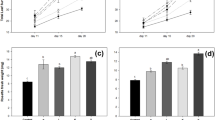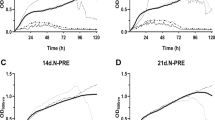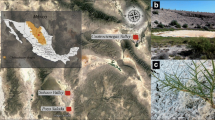Abstract
The interaction of plants with bacteria and the long-term success of their adaptation to challenging environments depend upon critical traits that include nutrient solubilization, remodeling of root architecture, and modulation of host hormonal status. To examine whether bacterial promotion of phosphate solubilization, root branching and the host auxin response may account for plant growth, we isolated and characterized ten bacterial strains based on their high capability to solubilize calcium phosphate. All strains could be grouped into six Pseudomonas species, namely P. brassicae, P. baetica, P. laurylsulfatiphila, P. chlororaphis, P. lurida, and P. extremorientalis via 16S rRNA molecular analyses. A Solibacillus isronensis strain was also identified, which remained neutral when interacting with Arabidopsis roots, and thus could be used as inoculation control. The interaction of Arabidopsis seedlings with bacterial streaks from pure cultures in vitro indicated that their phytostimulation properties largely differ, since P. brassicae and P. laurylsulfatiphila strongly increased shoot and root biomass, whereas the other species did not. Most bacterial isolates, except P. chlororaphis promoted lateral root formation, and P. lurida and P. chlororaphis strongly enhanced expression of the auxin-inducible gene construct DR5:GUS in roots, but the most bioactive probiotic bacterium P. brassicae could not enhance the auxin response. Inoculation with P. brassicae and P. lurida improved shoot and root growth in medium supplemented with calcium phosphate as the sole Pi source. Collectively, our data indicate the differential responses of Arabidopsis seedlings to inoculation with several Pseudomonas species and highlight the potential of P. brassicae to manage phosphate nutrition and plant growth in a more eco-friendly manner.







Similar content being viewed by others
Data Availability
All data generated or analysed during this study are included in this article and are available upon reasonable request to the corresponding author.
References
Backer R, Rokem SJ, Ilangumaran G et al (2018) Plant growth-promoting rhizobacteria: context, mechanisms of action, and roadmap to commercialization of biostimulants for sustainable agriculture. Front Plant Sci 9:1473. https://doi.org/10.3389/fpls.2018.01473
Finkel OM, Castrillo G, Paredes SH et al (2017) Understanding and exploiting plant beneficial microbes. Curr Opin Plant Biol 38:155–163. https://doi.org/10.1016/j.pbi.2017.04.018
Finkel OM, Salas-González I, Castrillo G et al (2020) A single bacterial genus maintains root growth in a complex microbiome. Nature 587:103–108. https://doi.org/10.1038/s41586-020-2778-7
Wang S, Na X, Yang L et al (2021) Bacillus megaterium strain WW1211 promotes plant growth and lateral root initiation via regulation of auxin biosynthesis and redistribution. Plant Soil 466:491–504. https://doi.org/10.1007/s11104-021-05055-z
López-Arredondo D, Leyva-González MA, González-Morales S et al (2014) Phosphate nutrition: improving low phosphate tolerance in crops. Annu Rev Plant Biol 65:95–123. https://doi.org/10.1146/annurev-arplant-050213-035949
Shahid M, Hameed S, Tariq M et al (2015) Characterization of mineral phosphate-solubilizing bacteria for enhanced sunflower growth and yield-attributing traits. Ann Microbiol 65:1525–1536. https://doi.org/10.1007/s13213-014-0991-z
Alori ET, Glick BR, Babalola OO (2017) Microbial phosphorus solubilization and its potential for use in sustainable agriculture. Front Microbiol 8:971. https://doi.org/10.3389/fmicb.2017.00971
Ortiz-Castro R, López-Bucio J (2019) Review: Phytostimulation and root architectural responses to quorum-sensing signals and related molecules from rhizobacteria. Plant Sci 284:135–142. https://doi.org/10.1016/j.plantsci.2019.04.010
Ortiz-Castro R, Díaz-Pérez C, Martínez-Trujillo M et al (2011) Transkingdom signaling based on bacterial cyclodipeptides with auxin activity in plants. Proc Natl Acad Sci USA 108:7253–7258. https://doi.org/10.1073/pnas.1006740108
Ortiz-Castro R, Campos-García J, López-Bucio J (2020) Pseudomonas putida and Pseudomonas fluorescens influence Arabidopsis root system architecture through an auxin response mediated by bioactive cyclodipeptides. J Plant Growth Regul 39:254–265. https://doi.org/10.1007/s00344-019-09979-w
Spaepen S, Bossuyt S, Engelen K et al (2014) Phenotypical and molecular responses of Arabidopsis thaliana roots as a result of inoculation with the auxin-producing bacterium Azospirillum brasilense. New Phytol 201(3):850–861. https://doi.org/10.1111/nph.12590
Méndez-Gómez M, Barrera-Ortíz S, Castro-Mercado E et al (2020) The nature of the interaction Azospirillum-Arabidopsis determines the molecular and morphological changes in root and plant growth promotion. Protoplasma 258:179–189. https://doi.org/10.1007/s00709-020-01552-7
García-Cárdenas E, Ortiz-Castro R, Ruiz-Herrera LF, et al (2021) Micrococcus luteus LS570 promotes root branching in Arabidopsis via decreasing apical dominance of the primary root and an enhanced auxin response. Protoplasma https://doi.org/10.1007/s00709-021-01724-z
Jiménez-Vázquez K, García-Cárdenas E, Barrera-Ortíz S et al (2020) The plant beneficial rhizobacterium Achromobacter sp. 5B1 influences root development through auxin signaling and redistribution. Plant J 103:1639–1654. https://doi.org/10.1111/tpj.14853
Ulmasov T, Murfett J, Hagen G, Guilfoyle TJ (1997) Aux/IAA proteins repress expression of reporter genes containing natural and highly active synthetic auxin response elements. Plant Cell 9:1963–1971. https://doi.org/10.1105/tpc.9.11.1963
Murashige T, Skoog F (1962) A revised medium for rapid growth and bioassays with tobacco tissue culture. Physiol Plant 15:473–497. https://doi.org/10.1111/j.1399-3054.1962.tb08052.x
Tzec-Interian JA, Desgarennes D, Carrión G et al (2020) Characterization of plant growth-promoting bacteria associated with avocado trees(PerseaamericanaMiller) and their potential use in the biocontrol ofScirtothripsperseae(avocado thrips). PloS One 15(4):e0231215.https://doi.org/10.1371/journal.pone.0231215
Wright ES (2012) DECIPHER, a search-based approach to chimera identification for 16S rRNA sequences. Appl Environ Microbiol 78(3):717–725. https://doi.org/10.1128/AEM.06516-11
Altschul SF, Gish W, Miller W et al (1990) Basic local alignment search tool. J Mol Biol 215:403–410. https://doi.org/10.1016/S0022-2836(05)80360-2
Quast C, Pruesse E, Yilmaz P et al (2013) The SILVA ribosomal RNA gene database project: improved data processing and web-based tools. Nucl Acids Res 41(D1):D590–D596. https://doi.org/10.1093/nar/gks1219
Cole JR, Wang Q, Fish JA et al (2014) Ribosomal Database Project: data and tools for high throughput rRNA analysis. Nucl Acids Res 42((Database issue)):D633-42. https://doi.org/10.1093/nar/gkt1244
Wang Q, Garrity GM, Tiedje JM, Cole JR (2007) Naïve Bayesian classifier for rapid assignment of rRNA sequences into the new bacterial taxonomy. Appl Environ Microbiol 73:5261–5267. https://doi.org/10.1128/AEM.00062-07
Larsen N, Olsen GJ, Maidak BL et al (1993) The ribosomal database project. Nucl Acids Res 21:3021–3023. https://doi.org/10.1093/nar/21.13.3021
Cole JR, Chai B, Farris RJ et al (2005) The Ribosomal Database Project (RDP-II): sequences and tools for high-throughput rRNA analysis. Nucl Acids Res 33:D294–D296. https://doi.org/10.1093/nar/gki038
Kumar S, Stecher G, Tamura K (2016) MEGA7: molecular evolutionary genetics analysis version 7.0 for bigger datasets. Mol Biol Evol 33:1870–1874. https://doi.org/10.1093/molbev/msw054
Malamy JE, Benfey PN (1997) Organization and cell differentiation in lateral roots of Arabidopsis thaliana. Development 124:33–44. https://doi.org/10.1242/dev.124.1.33
Gupta RR, Singal A, Sankar RC et al (1994) Amodified plate assay for screening phosphate-solubilizing microorganisms. J Gen Appl Microbiol 40:255–260. https://doi.org/10.2323/jgam.40.255
Nautiyal CS (1999) An efficient microbiological growth medium for screening phosphate solubilizing microorganisms. FEMS Microbiol Lett 170:265–270. https://doi.org/10.1111/j.1574-6968.1999.tb13383.x
Ortiz-Castro R, Contreras-Cornejo HA, Macías-Rodríguez L, López-Bucio J (2009) The role of microbial signals in plant growth and development. Plant SignalBehav 4(8):701–712. https://doi.org/10.4161/psb.4.8.9047
López-Bucio J, De la Vega OM, Guevara-García A, Herrera-Estrella L (2000) Enhanced phosphorus uptake in transgenic tobacco plants that overproduce citrate. Nat Biotechnol 18(4):450–453. https://doi.org/10.1038/74531
Rosas SB, Andrés JA, Rovera M, Correa NS (2006) Phosphate-solubilizingPseudomonasputidacan influence the rhizobia–legume symbiosis. Soil Biol Biochem 38:3502–3505.https://doi.org/10.1016/j.soilbio.2006.05.008
Trivedi P, Sa T (2008) Pseudomonas corrugata (NRRL B-30409) mutants increased phosphate solubilization, organic acid production, and plant growth at lower temperatures. Curr Microbiol 56(2):140–144. https://doi.org/10.1007/s00284-007-9058-8
Adhikari P, Jain R, Sharma A, Pandey A (2021) Plant growth promotion at low temperature by phosphate-solubilizing Pseudomonas spp isolated from high-altitude Himalayan soil. Microbial Ecol 82(3):677–687. https://doi.org/10.1007/s00248-021-01702-1
Majeed A, KaleemAbbasi M, Hameed S et al (2018) Pseudomonas sp. AF-54 containing multiple plant beneficial traits acts as growth enhancer of Helianthus annuus L. under reduced fertilizer input. Microbiol Res 216:56–69. https://doi.org/10.1016/j.micres.2018.08.006
Bautista-Cruz A, Antonio-Revuelta B, Martínez-Gallegos VC, Báez-Pérez A (2019) Phosphate-solubilizing bacteria improve Agave angustifolia Haw. growth under field conditions. J Sci Food Agric 99:6601–6607. https://doi.org/10.1002/jsfa.9946
Tahir M, Naeem MA, Shahid M et al (2020) Inoculation of pqqE gene inhabiting Pantoea and Pseudomonas strains improves the growth and grain yield of wheat with a reduced amount of chemical fertilizer. J Appl Microbiol 129(3):575–589. https://doi.org/10.1111/jam.14630
Oteino N, Lally RD, Kiwanuka S et al (2015) Plant growth promotion induced by phosphate solubilizing endophytic Pseudomonas isolates. Front Microbiol 6:745. https://doi.org/10.3389/fmicb.2015.00745
Kazmierczak BI, Schniederberend M, Jain R (2015) Cross-regulation of Pseudomonas motility systems: the intimate relationship between flagella, pili and virulence. Curr Opin Microbiol 28:78–82. https://doi.org/10.1016/j.mib.2015.07.017
Raio A, Puopolo G (2021) Pseudomonas chlororaphis metabolites as biocontrol promoters of plant health and improved crop yield. World J Microbiol Biotechnol 37(6):99. https://doi.org/10.1007/s11274-021-03063-w
López-Bucio J, Hernández-Abreu E, Sánchez-Calderón L, Nieto-Jacobo MF, Simpson J, Herrera-Estrella L (2002) Phosphate availability alters architecture and causes changes in hormone sensitivity in the Arabidopsis root system. Plant Physiol 129(1):244–256. https://doi.org/10.1104/pp.010934
Castrillo G, Teixeira P, Paredes S et al (2017) Root microbiota drive direct integration of phosphate stress and immunity. Nature 543:513–518. https://doi.org/10.1038/nature21417
Brisson VL, Richardy J, Kosina SM et al (2022) Phosphate availability modulates root exudate composition and rhizosphere microbial community in a Teosintle and a modern maize cultivar. Phytobiomes J 6(1):83–94. https://doi.org/10.1094/PBIOMES-06-21-0041-R
Kawasaki A, Dennis PG, Forstner C et al (2021) Manipulating exudate composition from root apices shapes the microbiome throughout the root system. Plant Physiol 184:2279–2285. https://doi.org/10.1093/plphys/kiab337
Funding
This work was financed by grants from the Consejo Nacional de Ciencia y Tecnología (CONACYT, México, grants A1-S-34768, PDCPN-2015–882, and FORDECYT-PRONACES 292399) and UMSNH (CIC 2.26).
Author information
Authors and Affiliations
Contributions
J.L.H., R.O.C., and J.L.B. conceived and designed the experiments; J.L.H., E.G.C., K.R.J.V., D.L.S.R., and O.F.R. performed experiments; J.L.H., J.S.L.B., O.F.R., R.O.C., and J.L.B analyzed the data; R.O.C., J.S.L.B, H.R.C, and J.L.-B. provided reagents/materials/analytical tools; J.L.H. and J.L.B. wrote the paper; all authors reviewed and edited the manuscript. R.O.C. and J.L.B. applied for funding.
Corresponding author
Ethics declarations
Conflict of Interest
The authors declare no competing interests.
Rights and permissions
About this article
Cite this article
López-Hernández, J., García-Cárdenas, E., López-Bucio, J.S. et al. Screening of Phosphate Solubilization Identifies Six Pseudomonas Species with Contrasting Phytostimulation Properties in Arabidopsis Seedlings. Microb Ecol 86, 431–445 (2023). https://doi.org/10.1007/s00248-022-02080-y
Received:
Accepted:
Published:
Issue Date:
DOI: https://doi.org/10.1007/s00248-022-02080-y




